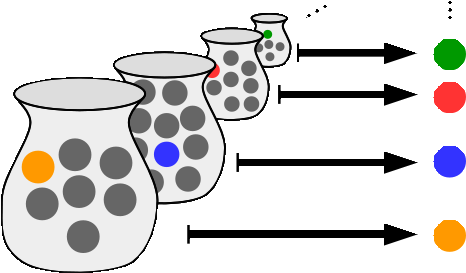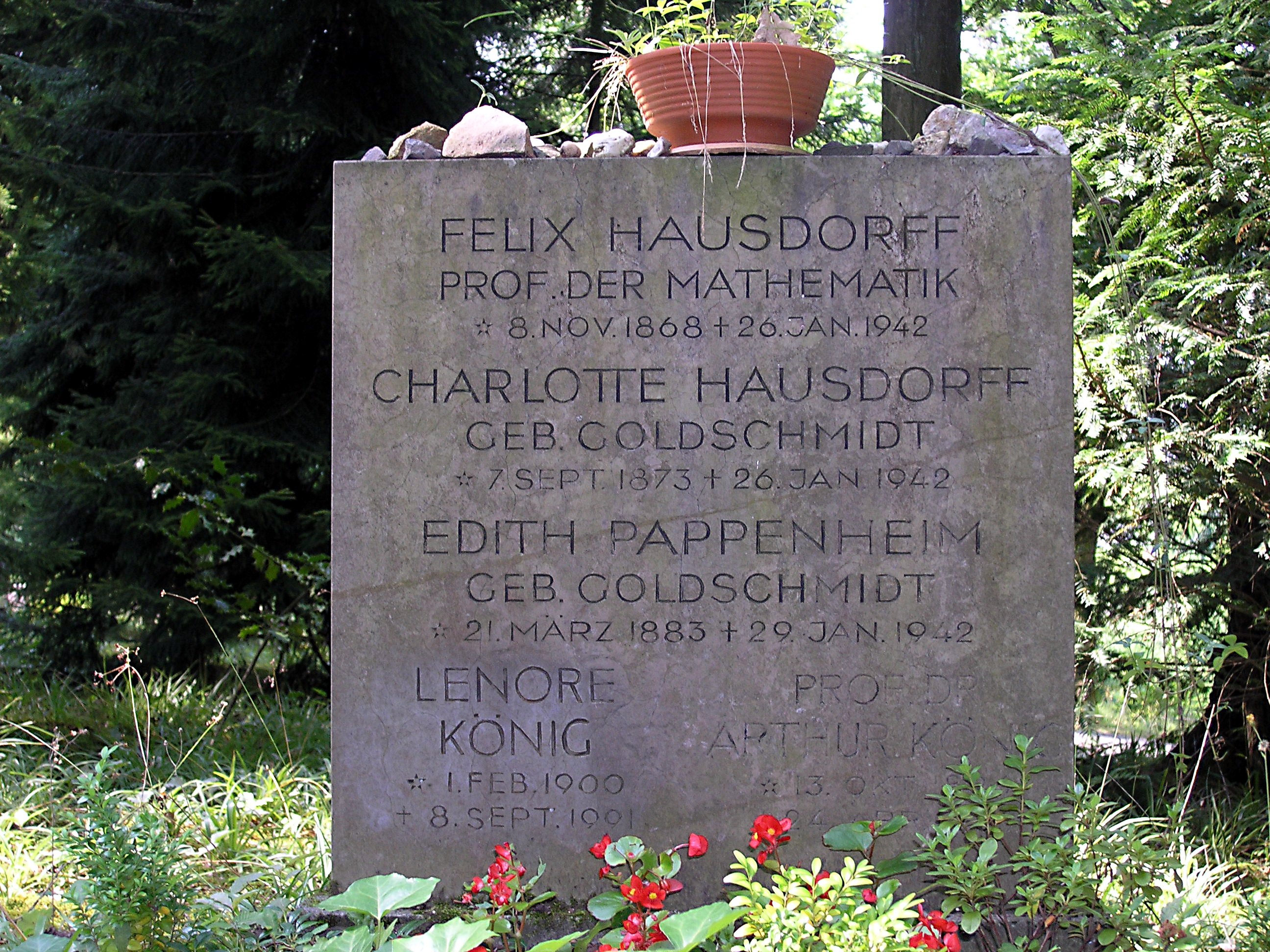|
Well-ordering Theorem
In mathematics, the well-ordering theorem, also known as Zermelo's theorem, states that every set can be well-ordered. A set ''X'' is ''well-ordered'' by a strict total order if every non-empty subset of ''X'' has a least element under the ordering. The well-ordering theorem together with Zorn's lemma are the most important mathematical statements that are equivalent to the axiom of choice (often called AC, see also ). Ernst Zermelo introduced the axiom of choice as an "unobjectionable logical principle" to prove the well-ordering theorem. One can conclude from the well-ordering theorem that every set is susceptible to transfinite induction, which is considered by mathematicians to be a powerful technique. One famous consequence of the theorem is the Banach–Tarski paradox. History Georg Cantor considered the well-ordering theorem to be a "fundamental principle of thought". However, it is considered difficult or even impossible to visualize a well-ordering of \mathbb, the set o ... [...More Info...] [...Related Items...] OR: [Wikipedia] [Google] [Baidu] |
Mathematics
Mathematics is a field of study that discovers and organizes methods, Mathematical theory, theories and theorems that are developed and Mathematical proof, proved for the needs of empirical sciences and mathematics itself. There are many areas of mathematics, which include number theory (the study of numbers), algebra (the study of formulas and related structures), geometry (the study of shapes and spaces that contain them), Mathematical analysis, analysis (the study of continuous changes), and set theory (presently used as a foundation for all mathematics). Mathematics involves the description and manipulation of mathematical object, abstract objects that consist of either abstraction (mathematics), abstractions from nature orin modern mathematicspurely abstract entities that are stipulated to have certain properties, called axioms. Mathematics uses pure reason to proof (mathematics), prove properties of objects, a ''proof'' consisting of a succession of applications of in ... [...More Info...] [...Related Items...] OR: [Wikipedia] [Google] [Baidu] |
Gyula Kőnig
Gyula Kőnig (16 December 1849 – 8 April 1913) was a mathematician from Hungary. His mathematical publications in German appeared under the name Julius König. His son Dénes Kőnig was a graph theorist. Biography Gyula Kőnig was active literarily and mathematically. He studied medicine in Vienna and, from 1868 on, in Heidelberg. After having worked, instructed by Hermann von Helmholtz, on electrical stimulation of nerves, he switched to mathematics. He obtained his doctorate under the supervision of the mathematician Leo Königsberger. His thesis ''Zur Theorie der Modulargleichungen der elliptischen Functionen'' covers 24 pages. As a post-doc he completed his mathematical studies in Berlin attending lessons by Leopold Kronecker and Karl Weierstraß. He then returned to Budapest, where he was appointed as a ''dozent'' at the university in 1871. He became a professor at the Teacher's College in Budapest in 1873 and, in the following year, was appointed professor at the Techn ... [...More Info...] [...Related Items...] OR: [Wikipedia] [Google] [Baidu] |
Axiom Of Choice
In mathematics, the axiom of choice, abbreviated AC or AoC, is an axiom of set theory. Informally put, the axiom of choice says that given any collection of non-empty sets, it is possible to construct a new set by choosing one element from each set, even if the collection is infinite. Formally, it states that for every indexed family (S_i)_ of nonempty sets (S_i as a nonempty set indexed with i), there exists an indexed set (x_i)_ such that x_i \in S_i for every i \in I. The axiom of choice was formulated in 1904 by Ernst Zermelo in order to formalize his proof of the well-ordering theorem. The axiom of choice is equivalent to the statement that every partition has a transversal. In many cases, a set created by choosing elements can be made without invoking the axiom of choice, particularly if the number of sets from which to choose the elements is finite, or if a canonical rule on how to choose the elements is available — some distinguishing property that happens to ... [...More Info...] [...Related Items...] OR: [Wikipedia] [Google] [Baidu] |
Mizar System
The Mizar system consists of a formal language for writing mathematical definitions and proofs, a proof assistant, which is able to mechanically check proofs written in this language, and a library of formalized mathematics, which can be used in the proof of new theorems. The system is maintained and developed by the Mizar Project, formerly under the direction of its founder Andrzej Trybulec. In 2009 the Mizar Mathematical Library was the largest coherent body of strictly formalized mathematics in existence. History The Mizar Project was started around 1973 by Andrzej Trybulec as an attempt to reconstruct mathematical vernacular so it can be checked by a computer. Its current goal, apart from the continual development of the Mizar System, is the collaborative creation of a large library of formally verified proofs, covering most of the core of modern mathematics. This is in line with the influential QED manifesto. Currently the project is developed and maintained by re ... [...More Info...] [...Related Items...] OR: [Wikipedia] [Google] [Baidu] |
Ordinal Number
In set theory, an ordinal number, or ordinal, is a generalization of ordinal numerals (first, second, th, etc.) aimed to extend enumeration to infinite sets. A finite set can be enumerated by successively labeling each element with the least natural number that has not been previously used. To extend this process to various infinite sets, ordinal numbers are defined more generally using linearly ordered greek letter variables that include the natural numbers and have the property that every set of ordinals has a least or "smallest" element (this is needed for giving a meaning to "the least unused element"). This more general definition allows us to define an ordinal number \omega (omega) to be the least element that is greater than every natural number, along with ordinal numbers , , etc., which are even greater than . A linear order such that every non-empty subset has a least element is called a well-order. The axiom of choice implies that every set can be well-orde ... [...More Info...] [...Related Items...] OR: [Wikipedia] [Google] [Baidu] |
Springer Publishing
Springer Publishing Company is an American publishing company of academic journals and books, focusing on the fields of nursing, gerontology, psychology, social work, counseling, public health, and rehabilitation (neuropsychology). It was established in 1951 by Bernhard Springer, a great-grandson of Julius Springer, and is based in Midtown Manhattan, New York City. History Springer Publishing Company was founded in 1950 by Bernhard Springer, the Berlin-born great-grandson of Julius Springer, who founded Springer Science+Business Media, Springer-Verlag (now Springer Science+Business Media). Springer Publishing's first landmark publications included ''Livestock Health Encyclopedia'' by R. Seiden and the 1952 ''Handbook of Cardiology for Nurses''. The company's books soon branched into other fields, including medicine and psychology. Nursing publications grew rapidly in number, as Modell's ''Drugs in Current Use'', a small annual paperback, sold over 150,000 copies over several edi ... [...More Info...] [...Related Items...] OR: [Wikipedia] [Google] [Baidu] |
Second-order Logic
In logic and mathematics, second-order logic is an extension of first-order logic, which itself is an extension of propositional logic. Second-order logic is in turn extended by higher-order logic and type theory. First-order logic quantifies only variables that range over individuals (elements of the domain of discourse); second-order logic, in addition, quantifies over relations. For example, the second-order sentence \forall P\,\forall x (Px \lor \neg Px) says that for every formula ''P'', and every individual ''x'', either ''Px'' is true or not(''Px'') is true (this is the law of excluded middle). Second-order logic also includes quantification over sets, functions, and other variables (see section below). Both first-order and second-order logic use the idea of a domain of discourse (often called simply the "domain" or the "universe"). The domain is a set over which individual elements may be quantified. Examples First-order logic can quantify over individuals, but no ... [...More Info...] [...Related Items...] OR: [Wikipedia] [Google] [Baidu] |
First-order Logic
First-order logic, also called predicate logic, predicate calculus, or quantificational logic, is a collection of formal systems used in mathematics, philosophy, linguistics, and computer science. First-order logic uses quantified variables over non-logical objects, and allows the use of sentences that contain variables. Rather than propositions such as "all humans are mortal", in first-order logic one can have expressions in the form "for all ''x'', if ''x'' is a human, then ''x'' is mortal", where "for all ''x"'' is a quantifier, ''x'' is a variable, and "... ''is a human''" and "... ''is mortal''" are predicates. This distinguishes it from propositional logic, which does not use quantifiers or relations; in this sense, propositional logic is the foundation of first-order logic. A theory about a topic, such as set theory, a theory for groups,A. Tarski, ''Undecidable Theories'' (1953), p. 77. Studies in Logic and the Foundation of Mathematics, North-Holland or a formal theory o ... [...More Info...] [...Related Items...] OR: [Wikipedia] [Google] [Baidu] |
Felix Hausdorff
Felix Hausdorff ( , ; November 8, 1868 – January 26, 1942) was a German mathematician, pseudonym Paul Mongré (''à mogré' (Fr.) = "according to my taste"), who is considered to be one of the founders of modern topology and who contributed significantly to set theory, descriptive set theory, measure theory, and functional analysis. Hausdorff was Jewish, and life became difficult for him and his family after the '' Kristallnacht'' of 1938. The next year he initiated efforts to emigrate to the United States, but was unable to make arrangements to receive a research fellowship. On 26 January 1942, Hausdorff, along with his wife and his sister-in-law, died by suicide by taking an overdose of veronal, rather than comply with German orders to move to the Endenich camp, and there suffer the likely implications, about which he held no illusions. Life Childhood and youth Hausdorff's father, the Jewish merchant Louis Hausdorff (1843–1896), moved with his young family to Leipzig in t ... [...More Info...] [...Related Items...] OR: [Wikipedia] [Google] [Baidu] |
Real Number
In mathematics, a real number is a number that can be used to measure a continuous one- dimensional quantity such as a duration or temperature. Here, ''continuous'' means that pairs of values can have arbitrarily small differences. Every real number can be almost uniquely represented by an infinite decimal expansion. The real numbers are fundamental in calculus (and in many other branches of mathematics), in particular by their role in the classical definitions of limits, continuity and derivatives. The set of real numbers, sometimes called "the reals", is traditionally denoted by a bold , often using blackboard bold, . The adjective ''real'', used in the 17th century by René Descartes, distinguishes real numbers from imaginary numbers such as the square roots of . The real numbers include the rational numbers, such as the integer and the fraction . The rest of the real numbers are called irrational numbers. Some irrational numbers (as well as all the rationals) a ... [...More Info...] [...Related Items...] OR: [Wikipedia] [Google] [Baidu] |
Set (mathematics)
In mathematics, a set is a collection of different things; the things are '' elements'' or ''members'' of the set and are typically mathematical objects: numbers, symbols, points in space, lines, other geometric shapes, variables, or other sets. A set may be finite or infinite. There is a unique set with no elements, called the empty set; a set with a single element is a singleton. Sets are ubiquitous in modern mathematics. Indeed, set theory, more specifically Zermelo–Fraenkel set theory, has been the standard way to provide rigorous foundations for all branches of mathematics since the first half of the 20th century. Context Before the end of the 19th century, sets were not studied specifically, and were not clearly distinguished from sequences. Most mathematicians considered infinity as potentialmeaning that it is the result of an endless processand were reluctant to consider infinite sets, that is sets whose number of members is not a natural number. Specific ... [...More Info...] [...Related Items...] OR: [Wikipedia] [Google] [Baidu] |



